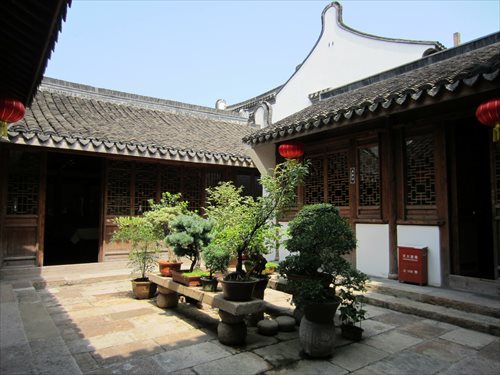Discovering Gaoqiao
When talking about old towns in Shanghai, you likely think of big names like Qibao or Zhujiajiao. Few, however, would think of Gaoqiao, a town located in the north of Pudong with over 800 years' history dating back to the Southern Song Dynasty (1127-1279).
The town of Gaoqiao adjoins the Yangtze River estuary to the north, the Huangpu River to the west and the Waigaoqiao Port to the south, covering a total area of 38.73 square kilometers.

Gaoqiao Historical and Cultural Exhibition Hall

Inside Yangxian Hall

Gaoqiao Painting and Calligraphy Academy and Pudong Chinese Painting Academy Photos: Courtesy of Gaoqiao town government
Recently, a batch of historical buildings on Gaoqiao Old Street were repaired and opened to the public free of charge. The Global Times visited the ancient street in an effort to trace the mysterious beauty of the laid-back town mellowed by history.
Run through by a T-shaped river course, Gaoqiao Old Street is divided into three parts, namely the north, east and west streets. On the east street is a detached steel concrete house that has stood for more than 80 years. The house is named "Yangxian Hall," literally meaning "admiring people of virtue." Now it serves as Gaoqiao Historical and Cultural Exhibition Hall featuring over 600 cultural relics collected from locals.
Wang Yixiang, a senior official in charge of the intangible cultural heritage administration of Gaoqiao, said Yangxian Hall is also called "the residence of Shen," as its former owner was Gaoqiao native Shen Jinfu. "Shen was mainly engaged in selling foreign goods like flour, kerosene, soaps and matches, so he had many chances to come into contact with the Western world. When the hall was first being built, a lot of foreign architectural elements were integrated. Many items in the building are imports from abroad such as the mantelpiece, floor materials and even the bronze door bolts," Wang said.
In pursuit of safety and security in handling all matters, Shen devoted particular care to ensuring high standards of workmanship and materials. During the liberation of Shanghai in 1949, the hall, which was then used as a stronghold due to its favorable height, survived fierce battles by means of its firm structure, as evidenced by some bullet holes left in the walls.
Gaoqiao has been renowned for being home to artisans and architects, whose skill has been made use of throughout the city. One-third of the old buildings on the Bund of Shanghai were built by people from Gaoqiao.
Other masterworks left by the builders include China's first power plant, first gas plant, first bridge of all-steel structure and villas of three of the four big families surnamed Chiang, Soong, Kung and Chen of the Republic of China (1912-1949).
"As time went by, many of the old buildings got damaged by different degrees. But we have renovated them in accordance with historical records to maintain their original features," Wang said.
Gaoqiao also produced painter Qian Huian, known as being "the master of Shanghai-style art." Situated in Gaoqiao west street, Qian Huian Museum houses a large collection of his masterpieces. The museum also functions as Gaoqiao Painting and Calligraphy Academy and Pudong Chinese Painting Academy. Over 160 traditional Chinese paintings, calligraphic and seal cutting works by well-known Shanghai artists will be shown in the museum from October 29 to January 30 next year.
The town also has a strong tradition of embroidery, which can be seen at Gaoqiao Woolen Embroidery Museum. The technique came to Shanghai from Europe at the end of the 19th century. The town became the country's largest embroidery export base, shipping over 1.3 million pieces to over 40 countries and regions in 1980 alone. This technique was also listed in the Shanghai Intangible Cultural Heritage Conservation Directory in 2009.
Newspaper headline: Little-known water town opens restored buildings